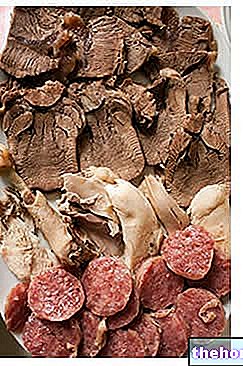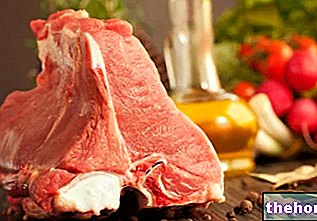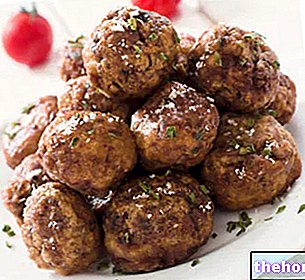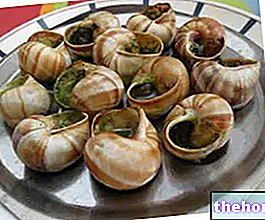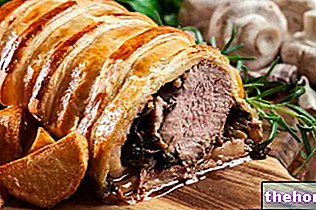Generality
Meatballs are a rustic and homemade food, which falls into the category of dishes.

Meatballs were born as a recycling system for cooked or raw foods. The passage to the meat grinder of scraps and small pieces of meat residues from other recipes is in fact a fairly common method for "not throwing anything away"; alternatively, you can perform a knife beating (now replaced by the mixer) of cooked leftovers, such as scallops, roasts, grilled meat, etc. The whole is then amalgamated by the egg, structured by the breadcrumbs, flavored by the cheese and adjusted with the aroma with the various spices, thus obtaining the meatballs ready to cook.
From a sanitary point of view, meatballs are not always considered a safe food; as they are often used to “dispose” of wasting meats, they should be excluded from the diet of subjects potentially at risk of complications. Below we will understand better why.
Meatballs for All Tastes
Traditional Italian meatballs
Meatballs are traditionally composed of ingredients of both animal and vegetable origin. The classic Italian recipe (if there is one ...), involves the use of: minced meat, eggs, breadcrumbs, cheese, aromatic herbs, salt, pepper and vegetable oil for frying. NB. The ingredients have not been specified in the quantities precisely in relation to the great heterogeneity of the territorial formulas.
This promiscuity totally excludes them from the vegan philosophy and the ovo ovo vegetarian philosophy. There are also many other discrepancies of a religious nature, for which meatballs should be eliminated from Muslim (if they contain pork), Hindu (if they contain beef), kosher (if they contain pork), kosher (if they contain pork, for the mixture of meat and cheese, if the meat comes from animals that have not been slaughtered according to the Sechita ritual etc.).
Referring again to traditional Italian meatballs, it is a food that does not lend itself to the diet against overweight, the diet against hypercholesterolemia, the diet against disorders of the gastro-intestinal tract, the diet against the tendency to biliary lithiasis and to clinical nutrition in general.They contain gluten, lactose, milk proteins, egg proteins (whole) and sometimes seed oils; they are therefore impertinent to the diet against celiac disease, to the diet against lactose intolerance and to the exclusion diet against the allergens contained in the aforementioned foods.
VARIANTS
Compared to the traditional recipe, there are dozens (perhaps over a hundred) variations of meatballs. There are minced meatballs, chopped with a knife or mixed with a food processor; breaded and fried meatballs, cooked in the oven, stewed in sauce, sautéed in a pan or vacuum-boiled at low temperature; meatballs without bread, without eggs, without yolk or without cheese; meatballs based on fish, based on offal, based on legumes, based on cereals (or other seeds), based on fruits and / or vegetables or based on food for vegans. Each ingredient can be added or removed, always keeping in mind that the dough should remain compact and tasty.
They are foods quite similar to meatballs: meatloaf, hamburgers (or burgers), raw Piedmontese meat, tartare (meat or fish), various croquettes etc.
Sanitary Hygienic Aspects
As anticipated, meatballs are not always considered a safe food from a health and hygiene point of view and, in certain places of collective catering, it would sometimes be wiser to exclude them from the diet of potentially at risk subjects; these include: pregnant women, children in weaning or in any case small, very elderly subjects, compromised or immunodeficient subjects, etc.
Let's be clear, a food prepared at home, from fresh and controlled foods, if properly cooked, can be eaten by practically anyone. The same, however, cannot be said of the meatballs offered in certain restaurants or fast-food restaurants.
The risks associated with the consumption of meatballs are mainly linked to three factors: parasitic contamination of meat or fish, bacterial contamination of any ingredient and the presence of bone splinters. Let's proceed in order.
- Parasitic contamination of meat: it may be due to a premortem or postmortem condition of the animal used for the meat, depending on the type of parasite; some are: toxoplasma, tapeworm, trichinella, ascarid, pinworms and anisakis (the latter only for the tissues of the fish). It is true that meatballs must always be cooked and that there is no parasite that can withstand heat treatment above 70 ° C or much below 0 (-20 ° C). Keeping in mind that the most moderate cooking technique is the "low temperature vacuum boiling", which uses 60, 65 or at most 70 ° C (for a very long period), the risk should be practically reduced "to the bone" ". With the other cooking systems, the temperatures rise dramatically, ensuring a certain guarantee of disinfestation. On the other hand, it is not uncommon that, during frying or stir-frying, the temperatures are exceeded, risking scorching the meatballs. . These (already more tenacious to cooking than whole meat), if large and spherical in shape, will hardly reach a desirable temperature “at the heart of the food” for the disinfestation of the meat.
- Bacterial contamination of meatballs: Bacteria are a real scourge for meatballs, as well as for other ground foods. Those most responsible for human diseases are: the Clostridium perfringens, lo Staphylococcus aureus, Salmonella etc., which can contaminate the ingredients before or after grinding, compromising their conservation. Let's not forget that the maintenance of food is strictly influenced by their contact surface and the consequent adhesion of microorganisms to the substrate; since meatballs are made up of chopped or ground ingredients, their potential for contamination is much higher than a "whole" product. Unlike parasites, bacteria are able to replicate quickly, to produce spores (some very resistant to these temperatures) and to produce endo- or exo-toxins. All this translates into the fact that frozen foods, even brought to -20 ° C, cannot be considered sterile. The conservation of meatballs (raw or cooked) is therefore extremely limited compared to single whole ingredients. The "low temperature vacuum boiling" does not guarantee the "hygiene of the meatballs. The superior and accurate cooking can eliminate the bacteria and related exotoxins (which are proteinaceous), but more difficult to annihilate their spores, which can bloom once reduced temperature (for example, when stored in the refrigerator). No type of cooking can eliminate the endotoxins of their cell membrane, as they are lipidic in nature, therefore thermostable; ergo, dead bacteria, a source of endotoxins, can still cause "food poisoning .
- Presence of bone splinters: this is a problem linked above all to the feeding of children and dysphagia to solids, who often like this kind of food because it is soft and easy to chew. On the other hand, since it is a food probably made up of surplus meat scraps, it is not uncommon for it to contain bone or cartilage fragments. Mostly these are very small pieces that do not affect the health of those who ingest them in the least; more rarely, they can scratch the esophagus, impair swallowing and / or stimulate the urge to vomit.
Nutritional Characteristics
Defining the nutritional properties of meatballs is certainly not an easy task. As stated in the chapter “Meatballs for All Tastes”, the variations of this food are as many as the ingredients available to humans.
It is however possible to define that, in Italy, the most consumed types of meatballs are: fried meatballs, stewed meatballs with sauce, fish balls and soy balls.
Below, you can find a summary nutritional table of these recipes:
Fried
Stew
with sauce
of Tomato
of Salmon and Cod
baked
of Soy
(Miso, Okara)
As can be seen from the summary table, the preparation with the most calories is undoubtedly that of fried meatballs. It boasts a higher content of lipids and proteins, while carbohydrates are higher in vegan soy meatballs.
Cholesterol is higher in fried meatballs, while fiber is higher in soy vegan ones.
From a vitamin and salt point of view there is not much to add, except that the derivatives of animal origin contain a greater quantity of molecules of group B.
Taking meatballs into consideration, it is necessary to specify that they are not suitable for nutritional therapy. Fried meatballs do not lend themselves to the treatment of overweight subjects due to their very high caloric intake. In addition, they should also be avoided by people with hypercholesterolemia, regarding the considerably more significant content of cholesterol and saturated fatty acids.
Video Recipe Meatballs Light without eggs
NB. * The proportion of polyunsaturated (beneficial) fatty acids in fried meatballs is quite high because, in the recipe, the use of a frying oil based on various seeds is recommended. In reality, this is not the best product for this kind of preparation and, even if the value of polyunsaturates seems quite significant, they are still damaged by heat, losing all metabolic properties.
People with gastrointestinal and / or digestive disorders should also limit the consumption of fried meatballs. These are not easy to digest foods, which is why they are completely inadvisable in case of: gastritis, gastroesophageal reflux, peptic ulcer, tendency to biliary lithiasis and irritable colon.
Most types of meatballs contain gluten (except for gluten-free ones), which is why they should be avoided by celiacs. Likewise, due to the presence of cheese (except for vegan ones), lactose intolerant people should eliminate or drastically limit their consumption.
Other Foods - Amatriciana Meat Lamb - Lamb Meat Duck - Duck Meat Pork Chop Florentine Steak Boiled Broth Raw Meat Red Meat White Meat Beef Horse Meat Rabbit Meat Pork Meat Vegetable Meat Lean Meat Sheep and Goat Meat Carpaccio Ribs Cotechino Cutlet Snails or land snails Pheasant and Pheasant meat Guinea fowl - Guinea fowl meat Pork fillet Chicken Hamburger Hot Dog Kebab Patè Chicken breast Turkey breast Chicken - Chicken meat Meatballs Porchetta Quail - Quail meat Ragù Sausage Game Zampone OTHER ARTICLES MEAT Categories Food Alcoholic Meat Cereals and derivatives Sweeteners Sweets Offal Fruit Dried fruit Milk and derivatives Legumes Oils and fats Fish and fishery products Salami Spices Vegetables Health recipes Appetizers Bread, Pizza and Brioche First courses Second courses Vegetables and Salads Sweets and Desserts Ice creams and sorbets Syrups, liqueurs and grappas Preparations of Basic ---- In the Kitchen with Leftovers Carnival Recipes Christmas Recipes Diet Recipes Light Recipes Women's Day, Mom, Dad Functional Recipes International Recipes Easter Recipes Recipes for Celiacs Recipes for Diabetics Recipes for Holidays Recipes for Valentine's Day Recipes for Vegetarians Recipes Protein Regional Recipes Vegan Recipes

